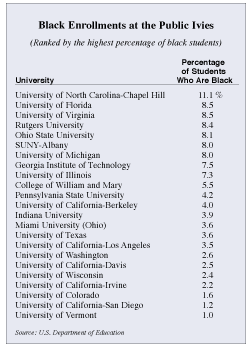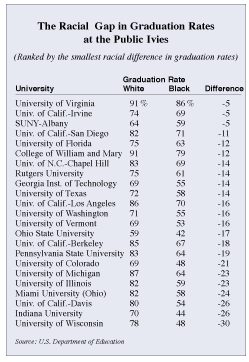| Comparing Black Enrollments at the Public Ivies Many of the nation's most prestigious state-operated universities now offer a standard of education comparable to that at the nation's highest-rated private colleges and universities. And they do so at a fraction of the cost.
A select group of state-operated institutions of higher education are successfully competing with the Ivy League schools in academic rigor. Over the years they have succeeded in attracting superstar faculty and in competing for the best and brightest students of all races.
In 1985 author Richard Moll coined the term "Public Ivies" in his book The Public Ivies: America's Flagship Undergraduate Colleges. At that time, Moll identified eight universities as public institutions that "provide an Ivy League collegiate experience at a public school price." The eight universities Moll named were the College of William and Mary, Miami University of Ohio, the University of California at Berkeley, the University of Michigan, the University of North Carolina at Chapel Hill, the University of Texas, the University of Vermont, and the University of Virginia. In 2001 Howard Greene and Matthew Greene published a new guide entitled The Public Ivies: America's Flagship Public Universities. In addition to the eight universities listed above, the Greenes included the following institutions in their group of Public Ivies: Indiana University, Ohio State University, Pennsylvania State University, Rutgers University, the State University of New York, the University of Colorado, the University of Florida, the University of Illinois, the University of Washington, and the University of Wisconsin. According to the latest rankings by U.S. News & World Report, there are five other institutions that should be considered among the nation's highest-ranked public universities. Four of the five are branches of the University of California: campuses at Davis, Irvine, Los Angeles, and San Diego. The other high-ranking public university on the U.S. News list is the Georgia Institute of Technology, commonly referred to as Georgia Tech. JBHE has compiled data on the black percentage of the student bodies at the institutions that appeared on one or more of the aforementioned lists of Public Ivies. At 11.1 percent, the University of North Carolina at Chapel Hill has the highest percentage of blacks in its student body of the Public Ivies. The University of Florida and the University of Virginia both have student bodies that are 8.5 percent black. Rutgers, Ohio State, SUNY-Albany, and the University of Michigan are the only other Public Ivies at which blacks make up at least 8 percent of the student body.
The University of Vermont has the lowest level of blacks in its student body. But this is not a surprise since blacks make up little more than 1 percent of the entire state's population. The five campuses of the University of California included in this group of Public Ivies all have a student body that is at most 4 percent black. But it must be remembered that because of state law these institutions are prohibited from using race as a factor in their admissions decisions. The same holds true for the University of Washington, where blacks are only 2.6 percent of the student body, and also at the University of Florida, which has a higher level of black enrollments but also a far larger pool of black students as potential applicants. It should be noted that at each one of this group of Public Ivies the black percentage of the student body is less than the black percentage of the college-age population in that particular state. Black Graduation Rates at the Public Ivies As expected, the black student graduation rate at each of these prestigious Public Ivies is higher than the national average for African-American college students, which stands at 40 percent. In general this is the case because these state-operated institutions tend to attract students with strong academic credentials who are more likely to complete college.
The University of Virginia has the highest black student graduation rate of this group at 86 percent. In fact, the black student graduation rate at the University of Virginia is higher than the black student graduation rate at four Ivy League institutions: Dartmouth, Cornell, Columbia, and the University of Pennsylvania. Three other Public Ivies have a black student graduation rate of at least 70 percent: the College of William and Mary, the University of California at San Diego, and the University of California at Los Angeles. The lowest black student graduation rate among this group of Public Ivies is at Ohio State University. There, only 42 percent of entering black students go on to earn a diploma at Ohio State within six years. Less than half of all entering black students fail to graduate at Indiana University, the University of Wisconsin, and the University of Colorado. One final way to compare the progress of black students at these Public Ivies is to calculate the difference in graduation rates between white and black students. Here we find that at most of the Public Ivies — as is the case at many of the elite private universities — the black student graduation rate is far below the rate for white students. In many cases the disparity is huge. For example, at the University of California at Davis, Indiana University, and the University of Wisconsin, the black student graduation rate is more than 25 percentage points lower than the rate for whites. At three of the Public Ivies, the black student graduation rate is only five percentage points below the rate for whites. This is the smallest difference among this group of universities. By far the most impressive is the University of Virginia with its high black student graduation rate of 86 percent and its small racial difference in graduation rates. | |






